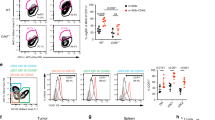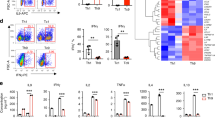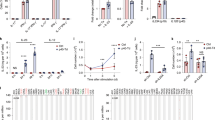Abstract
Infiltration, accumulation, and survival of chimeric antigen receptor T (CAR-T) cells in solid tumors is crucial for tumor clearance. We engineered CAR-T cells to express interleukin (IL)-7 and CCL19 (7 × 19 CAR-T cells), as these factors are essential for the maintenance of T-cell zones in lymphoid organs. In mice, 7 × 19 CAR-T cells achieved complete regression of pre-established solid tumors and prolonged mouse survival, with superior anti-tumor activity compared to conventional CAR-T cells. Histopathological analyses showed increased infiltration of dendritic cells (DC) and T cells into tumor tissues following 7 × 19 CAR-T cell therapy. Depletion of recipient T cells before 7 × 19 CAR-T cell administration dampened the therapeutic effects of 7 × 19 CAR-T cell treatment, suggesting that CAR-T cells and recipient immune cells collaborated to exert anti-tumor activity. Following treatment of mice with 7 × 19 CAR-T cells, both recipient conventional T cells and administered CAR-T cells generated memory responses against tumors.
This is a preview of subscription content, access via your institution
Access options
Access Nature and 54 other Nature Portfolio journals
Get Nature+, our best-value online-access subscription
$29.99 / 30 days
cancel any time
Subscribe to this journal
Receive 12 print issues and online access
$209.00 per year
only $17.42 per issue
Buy this article
- Purchase on Springer Link
- Instant access to full article PDF
Prices may be subject to local taxes which are calculated during checkout



Similar content being viewed by others
References
Duong, C.P., Yong, C.S., Kershaw, M.H., Slaney, C.Y. & Darcy, P.K. Cancer immunotherapy utilizing gene-modified T cells: From the bench to the clinic. Mol. Immunol. 67 2 Pt A, 46–57 (2015).
Srivastava, S. & Riddell, S.R. Engineering CAR-T cells: Design concepts. Trends Immunol. 36, 494–502 (2015).
Ramos, C.A., Savoldo, B. & Dotti, G. CD19-CAR trials. Cancer J. 20, 112–118 (2014).
Rosenberg, S.A. & Restifo, N.P. Adoptive cell transfer as personalized immunotherapy for human cancer. Science 348, 62–68 (2015).
Kakarla, S. & Gottschalk, S. CAR T cells for solid tumors: armed and ready to go? Cancer J. 20, 151–155 (2014).
Link, A. et al. Fibroblastic reticular cells in lymph nodes regulate the homeostasis of naive T cells. Nat. Immunol. 8, 1255–1265 (2007).
Luther, S.A. et al. Differing activities of homeostatic chemokines CCL19, CCL21, and CXCL12 in lymphocyte and dendritic cell recruitment and lymphoid neogenesis. J. Immunol. 169, 424–433 (2002).
Deng, W. et al. Use of the 2A peptide for generation of multi-transgenic pigs through a single round of nuclear transfer. PLoS One 6, e19986 (2011).
Kim, J.H. et al. High cleavage efficiency of a 2A peptide derived from porcine teschovirus-1 in human cell lines, zebrafish and mice. PLoS One 6, e18556 (2011).
Fry, T.J. & Mackall, C.L. Interleukin-7: master regulator of peripheral T-cell homeostasis? Trends Immunol. 22, 564–571 (2001).
Bradley, L.M., Haynes, L. & Swain, S.L. IL-7: maintaining T-cell memory and achieving homeostasis. Trends Immunol. 26, 172–176 (2005).
Jiang, Q. et al. Cell biology of IL-7, a key lymphotrophin. Cytokine Growth Factor Rev. 16, 513–533 (2005).
Yoshida, R. et al. EBI1-ligand chemokine (ELC) attracts a broad spectrum of lymphocytes: activated T cells strongly up-regulate CCR7 and efficiently migrate toward ELC. Int. Immunol. 10, 901–910 (1998).
Kellermann, S.A., Hudak, S., Oldham, E.R., Liu, Y.J. & McEvoy, L.M. The CC chemokine receptor-7 ligands 6Ckine and macrophage inflammatory protein-3 beta are potent chemoattractants for in vitro- and in vivo-derived dendritic cells. J. Immunol. 162, 3859–3864 (1999).
Tamada, K. et al. Redirecting gene-modified T cells toward various cancer types using tagged antibodies. Clin. Cancer Res. 18, 6436–6445 (2012).
Bracci, L. et al. Cyclophosphamide enhances the antitumor efficacy of adoptively transferred immune cells through the induction of cytokine expression, B-cell and T-cell homeostatic proliferation, and specific tumor infiltration. Clin. Cancer Res. 13, 644–653 (2007).
Proietti, E. et al. Importance of cyclophosphamide-induced bystander effect on T cells for a successful tumor eradication in response to adoptive immunotherapy in mice. J. Clin. Invest. 101, 429–441 (1998).
Adachi, K. & Tamada, K. Immune checkpoint blockade opens an avenue of cancer immunotherapy with a potent clinical efficacy. Cancer Sci. 106, 945–950 (2015).
Pellegrini, M. et al. IL-7 engages multiple mechanisms to overcome chronic viral infection and limit organ pathology. Cell 144, 601–613 (2011).
Penaranda, C. et al. IL-7 receptor blockade reverses autoimmune diabetes by promoting inhibition of effector/memory T cells. Proc. Natl. Acad. Sci. USA 109, 12668–12673 (2012).
Hou, L. et al. Type 1 interferon-induced IL-7 maintains CD8+ T-cell responses and homeostasis by suppressing PD-1 expression in viral hepatitis. Cell. Mol. Immunol. 12, 213–221 (2015).
Heninger, A.K. et al. IL-7 abrogates suppressive activity of human CD4+CD25+FOXP3+ regulatory T cells and allows expansion of alloreactive and autoreactive T cells. J. Immunol. 189, 5649–5658 (2012).
Pellegrini, M. et al. Adjuvant IL-7 antagonizes multiple cellular and molecular inhibitory networks to enhance immunotherapies. Nat. Med. 15, 528–536 (2009).
Zhong, X.S., Matsushita, M., Plotkin, J., Riviere, I. & Sadelain, M. Chimeric antigen receptors combining 4-1BB and CD28 signaling domains augment PI3kinase/AKT/Bcl-XL activation and CD8+ T cell-mediated tumor eradication. Mol. Ther. 18, 413–420 (2010).
Zhao, Z. et al. Structural design of engineered costimulation determines tumor rejection kinetics and persistence of CAR T cells. Cancer Cell 28, 415–428 (2015).
Till, B.G. et al. CD20-specific adoptive immunotherapy for lymphoma using a chimeric antigen receptor with both CD28 and 4-1BB domains: pilot clinical trial results. Blood 119, 3940–3950 (2012).
Zervos, E., Agle, S., Freistaedter, A.G., Jones, G.J. & Roper, R.L. Murine mesothelin: characterization, expression, and inhibition of tumor growth in a murine model of pancreatic cancer. J. Exp. Clin. Cancer Res. 35, 39 (2016).
Förster, R. et al. CCR7 coordinates the primary immune response by establishing functional microenvironments in secondary lymphoid organs. Cell 99, 23–33 (1999).
Luther, S.A., Tang, H.L., Hyman, P.L., Farr, A.G. & Cyster, J.G. Coexpression of the chemokines ELC and SLC by T zone stromal cells and deletion of the ELC gene in the plt/plt mouse. Proc. Natl. Acad. Sci. USA 97, 12694–12699 (2000).
Brown, F.D. & Turley, S.J. Fibroblastic reticular cells: organization and regulation of the T lymphocyte life cycle. J. Immunol. 194, 1389–1394 (2015).
Zenatti, P.P. et al. Oncogenic IL7R gain-of-function mutations in childhood T-cell acute lymphoblastic leukemia. Nat. Genet. 43, 932–939 (2011).
Shochat, C. et al. Gain-of-function mutations in interleukin-7 receptor-α (IL7R) in childhood acute lymphoblastic leukemias. J. Exp. Med. 208, 901–908 (2011).
Shochat, C. et al. Novel activating mutations lacking cysteine in type I cytokine receptors in acute lymphoblastic leukemia. Blood 124, 106–110 (2014).
Zhang, L. et al. CCL21/CCR7 axis contributed to CD133+ pancreatic cancer stem-like cell metastasis via EMT and Erk/NF-κB pathway. PLoS One 11, e0158529 (2016).
Shi, M., Chen, D., Yang, D. & Liu, X.Y. CCL21-CCR7 promotes the lymph node metastasis of esophageal squamous cell carcinoma by up-regulating MUC1. J. Exp. Clin. Cancer Res. 34, 149 (2015).
Lal, S., Lauer, U.M., Niethammer, D., Beck, J.F. & Schlegel, P.G. Suicide genes: past, present and future perspectives. Immunol. Today 21, 48–54 (2000).
Greco, R. et al. Improving the safety of cell therapy with the TK-suicide gene. Front. Pharmacol. 6, 95 (2015).
Maude, S.L., Teachey, D.T., Porter, D.L. & Grupp, S.A. CD19-targeted chimeric antigen receptor T-cell therapy for acute lymphoblastic leukemia. Blood 125, 4017–4023 (2015).
Sotillo, E. et al. Convergence of acquired mutations and alternative splicing of CD19 enables resistance to CART-19 immunotherapy. Cancer Discov. 5, 1282–1295 (2015).
Yang, J. & Rader, C. Cloning, expression, and purification of monoclonal antibodies in scFv-Fc format. Methods Mol. Biol. 901, 209–232 (2012).
Morgan, R.A. et al. Case report of a serious adverse event following the administration of T cells transduced with a chimeric antigen receptor recognizing ERBB2. Mol. Ther. 18, 843–851 (2010).
Geng, D. et al. Amplifying TLR-MyD88 signals within tumor-specific T cells enhances antitumor activity to suboptimal levels of weakly immunogenic tumor antigens. Cancer Res. 70, 7442–7454 (2010).
Johnson, L.A. et al. Gene therapy with human and mouse T-cell receptors mediates cancer regression and targets normal tissues expressing cognate antigen. Blood 114, 535–546 (2009).
Zheng, Z., Chinnasamy, N. & Morgan, R.A. Protein L: a novel reagent for the detection of chimeric antigen receptor (CAR) expression by flow cytometry. J. Transl. Med. 10, 29 (2012).
Acknowledgements
This study is supported by research funds from Project for Development of Innovative Research on Cancer Therapeutics (P-DIRECT) 14532963 (to K.T.), Practical Research for Innovative Cancer Control, and Project for Cancer Research and Therapeutic Evolution (P-CREATE) 16770206 (to K.T.), by Japan Agency for Medical Research and Development (AMED), and Noile-Immune Biotech Inc.
Author information
Authors and Affiliations
Contributions
K.A. and K.T. designed the experiments, analyzed the data, and wrote the manuscript; K.A., Y.K., T.N., N.O., and Y.S. produced CAR-T cells for the study; and K.A. performed the in vitro and in vivo experiments.
Corresponding author
Ethics declarations
Competing interests
K.T. and Y.S. hold stocks of Noile-Immune Biotech Inc. K.T. and Y.S. receive consulting fees from Noile-Immune Biotech Inc.
Supplementary information
Supplementary Text and Figures
Supplementary Figures 1–21 (PDF 3409 kb)
Rights and permissions
About this article
Cite this article
Adachi, K., Kano, Y., Nagai, T. et al. IL-7 and CCL19 expression in CAR-T cells improves immune cell infiltration and CAR-T cell survival in the tumor. Nat Biotechnol 36, 346–351 (2018). https://doi.org/10.1038/nbt.4086
Received:
Accepted:
Published:
Issue Date:
DOI: https://doi.org/10.1038/nbt.4086
This article is cited by
-
Current challenges and therapeutic advances of CAR-T cell therapy for solid tumors
Cancer Cell International (2024)
-
Enhanced cellular therapy: revolutionizing adoptive cellular therapy
Experimental Hematology & Oncology (2024)
-
Designer cell therapy for tissue regeneration
Inflammation and Regeneration (2024)
-
Research progress of the chemokine/chemokine receptor axes in the oncobiology of multiple myeloma (MM)
Cell Communication and Signaling (2024)
-
CAR T cell therapy for patients with solid tumours: key lessons to learn and unlearn
Nature Reviews Clinical Oncology (2024)



